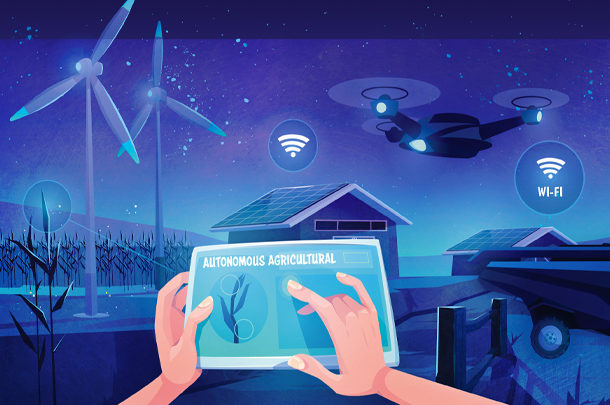Looking to the future, the possibility of fully autonomous farming equipment seems to be fast approaching. However, there are a few factors that contribute to the implementation and availability of this kind of technology, such as the likelihood of farmer adoption and infrastructure barriers. To address some of these factors and discuss what producers can expect from autonomous equipment in the coming years, machine writer Scott Garvey hosted the webinar “The Next Generation of Autonomous Ag” on March 10, as part of the Planting Kick Off event held by Canada’s Outdoor Farm Show.
Autonomous technology currently on the market
Now that many equipment companies are years into their autonomous equipment development process, some “spin-off” technologies established during this research and development process are already available to producers. This includes things like grain cart following technology and precision planting.
Matt Rushing, vice president of the crop care product line at AGCO, with whom Garvey also spoke, said there are benefits to the integration of these types of autonomous developments. “A lot of those things that we learn as we’re developing autonomous solutions, we can integrate in current machines and provide farmers with the initial benefits quicker than having to wait for them to adopt robots,” he explained.
Autonomous equipment adoption
As more of this technology becomes available to producers, Rushing said he expects farmers will be quick to adopt it. He noted two factors he believes will contribute to this:
- The level of acceptance of new technology has started to accelerate as farmers are now adopting and adapting to the use of a variety of new technologies within and beyond the scope of farming.
- Farmers now have a greater understanding of the benefits of technology in general and are beginning to further understand the benefits of autonomous technology and its potential to provide a high return on investment.
Equipment in development
The autonomous agricultural technology that has been unveiled and is anticipated to be available to farmers in the next few years includes autonomous implement carriers, tractors programmed to pull grain carts autonomously, tractors fitted with autonomous technology but which also function as conventional tractors and that can be used in tandem with conventional implements, and farm machinery that employs the “swarm” concept.
The swarm concept involves the use of many small autonomous machines on a single field. They work slowly but can seed a field on a 24-hour basis. Some equipment companies are also working on user interfaces to give producers access to autonomous machines, as well as the rest of a farm’s fleet, all on one platform which could be accessible through a phone or tablet.
Deciding if autonomy is right for your farm
Garvey spoke with Margaux Ascherl, the program delivery manager for autonomy at John Deere, about some of the motivations behind developing autonomous farm machinery and how the research and development behind it has already led to various innovations currently on the market.
Ascherl said autonomy should be viewed by a farm as one possible solution to their problems, not as something that exists for the sake of technological development. She also noted autonomous technology should only be implemented as it is suited to an individual farm’s operation and in cases where its operation would not create management issues.
Infrastructure concerns
Even as many autonomous machines are in the development stage, there are some infrastructure concerns that may need to be addressed before widespread adoption is seen. In many rural areas, broadband connectivity is limited and may not allow for the use of autonomous equipment, which often relies heavily on this connectivity. “From a GPS and positioning standpoint, that connectivity is required to be able to guide the machine through the field and allow it to perform its tasks,” Rushing said.
However, Ascherl argued, depending on the task there may still be autonomous options available in regions where broadband capabilities are an issue. She noted, “Any place that does not have full connectivity [could still] do autonomy.”
Owning and operating a fully autonomous fleet is still years away from becoming a reality; however, it seems many farms will have the opportunity to access autonomous technology as some of it trickles down and is incorporated in conventional equipment.
Before widespread use of autonomous equipment is seen, farms will need to understand the benefits it could bring them and what their options might be depending on the infrastructure in their area.










